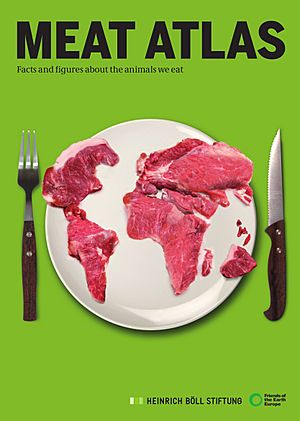Meat Atlas facts for kids
The Meat Atlas (also known as Der Fleischatlas) is a special report published every year. It is created by the Heinrich Böll Foundation and Friends of the Earth Europe. This report looks closely at how meat is produced on a large scale, often in big factories, and what effects this has on our world.
The main goal of the Meat Atlas is to help people understand more about where their meat comes from. It also explains the impact of modern meat production methods. Barbara Unmuessig, who leads the Heinrich Böll Foundation, said the report wants to show consumers the results of meat production becoming more and more like a factory process.
Contents
What the Meat Atlas Shows
The Meat Atlas shares important facts and figures about how we produce and eat meat. It helps us see the bigger picture of how our food choices affect the planet.
How Much Water Does Our Food Use?
Making food uses a lot of water. The Meat Atlas report uses information from the United Nations' Food and Agriculture Organization to show this. For example, producing just 1 kilogram (about 2.2 pounds) of beef needs about 15,455 liters (over 4,000 US gallons) of water.
Other foods also need water, but often less:
- Cheese needs about 5,000 liters for 1 kilogram.
- Rice needs about 3,400 liters for 1 kilogram.
- Carrots need only about 131 liters for 1 kilogram.
This shows that different foods have very different "water footprints."
Meat Consumption Around the World
People in different countries eat different amounts of meat each year. The report highlights these differences:
- In the United States, people eat over 75 kilograms (about 165 pounds) of meat per person each year.
- In Germany, the average is around 60 kilograms (about 132 pounds) per person.
- In China, it's about 38 kilograms (about 84 pounds) per person.
- In many parts of Africa, people eat less than 20 kilograms (about 44 pounds) of meat per person.
These numbers show how much meat is part of the diet in different places.
The Use of Antibiotics in Farming
Sometimes, farmers give antibiotics to animals like pigs. This can help the pigs grow faster and reach their market weight with 10 to 15 percent less food. However, using too many antibiotics can cause a big problem.
When antibiotics are used too often, bacteria can become resistant to them. These are called "antibiotic-resistant bacteria" or "superbugs." This means that the medicines might not work anymore when people get sick from these bacteria. It's a serious health concern for everyone.
See also
 In Spanish: Atlas de la carne para niños
In Spanish: Atlas de la carne para niños


